View in other NatureServe Network Field Guides
NatureServe
Montana
Utah
Wyoming
Idaho
Wisconsin
British Columbia
South Carolina
Yukon
California
New York
Clustered Plagiomnium Moss - Plagiomnium drummondii
General Description
Plants: Acrocarpous, growing in open tufts (Crum and Anderson et al. 1981) or mats (Lawton 1971), pale green or green with yellow tones (FNA 2014). Fertile stems upright (Lawton 1971), 10-40 mm tall, not tree-like (FNA 2014), with brown tomentum at the stem bottom (Lawton 1971); infertile stems sometimes reaching 70 mm (FNA 2014), spreading or arching, sometimes with radiculose tips (Crum and Anderson et al. 1981).
Leaves: Smaller and more distant below (Crum and Anderson et al. 1981), somewhat twisted, bent or curved when dry, plane (FNA 2014) and more-or-less upright to spreading about 45 degrees when damp (Crum and Anderson et al. 1981), 2-6 mm in length (FNA 2014), 1.5-2.5 mm in width (Lawton 1971), obovate or sometimes widest in the middle (FNA 2014) to ovate (Lawton 1971), narrowing to an acumen or acute leaf tip, or tip sometimes more widely-angled to curved, with a long-to-short, dentate cusp; base extending well down the stem; margins flat, sharply dentate from the apex to mid-leaf or to slightly lower; costa reaching or exceeding the leaf tip (FNA 2014).
Leaf Cells: Marginal teeth 1- to 2-celled, or seldom 3-celled; cells at the leaf edge arranged in 1 layer, long and thin, in 2-4 series; medial laminal cells with length about the same as or a little longer than the width (FNA 2014), the cells 6-sided (Lawton 1971) and smaller near the margins, occurring in up-and-down rows rather than obliquely-rowed, nonporose (FNA 2014), fine- to firmly-walled, the angles not thickened (Crum and Anderson et al. 1981).
Phenology
Fruit ripens in the last part of spring (FNA 2014).
Diagnostic Characteristics
The similar Plagiomnium cuspidatum also has obovate leaves that are sharply dentate above, but it never has multiple setae (FNA 2014).
Plagiomnium rostratum and P. ellipticum also have teeth only in the upper part of their leaves; their teeth, however, are usually dull and not as large as those of P. drummondii (FNA 2014).
The variation of characters within and among populations of Plagiomnium makes identification difficult without fertile plants (FNA 2014).
Range Comments
North American Range
Canada: NT, BC to NB and NS; USA: WA to MT, also NE, MN, OH, WV to NY, and NC (FNA 2014). Known in Montana from Flathead and Park Counties (Elliott and Pipp 2016).
Observations in Montana Natural Heritage Program Database
Number of Observations: 9
(Click on the following maps and charts to see full sized version)
Map Help and Descriptions
Relative Density
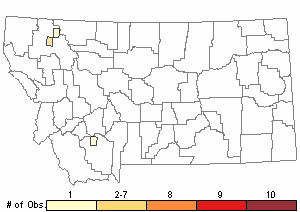
Recency
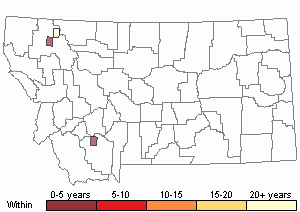
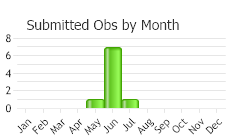
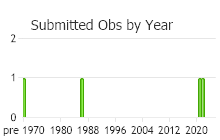
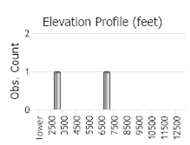 (Observations spanning multiple months or years are excluded from time charts)
(Observations spanning multiple months or years are excluded from time charts)
Habitat
Damp soil, humus, stone, rotting wood, bark; in wet woods and swamps. Occurring at low altitudes (FNA 2014).
Reproductive Characteristics
Archegonia and antheridia associating in the same bract cluster. Perigonial and perichaetial leaves to 6 mm (Lawton 1971). Seta 1 to multiple, rarely 4, per perichaetium, 12-30 mm tall (FNA 2014), ochre to brown (Lawton 1971), sometimes russet. Capsule 2-3 mm in length, drooping to level (FNA 2014), yellow to ochre (Lawton 1971), with an obscure neck (FNA 2014); stomata nearly to the surface with guard cells not at all hidden; exostome teeth yellow with green tones, papillose; endostome processes widely perforate with knobby cilia (Lawton 1971).
References
- Literature Cited AboveLegend:
 View Online Publication
View Online Publication Crum, H.A. and L.E. Anderson. 1981. Mosses of Eastern North America. 2 volumes. Columbia University Press, New York. 1328 pp.
Crum, H.A. and L.E. Anderson. 1981. Mosses of Eastern North America. 2 volumes. Columbia University Press, New York. 1328 pp. Elliott, J.C. and A.K. Pipp. 2018. A Checklist of Montana Mosses (1880-2018). Updated 3 January, 2020. Montana Natural Heritage Program, Helena, Montana. 73 pp.
Elliott, J.C. and A.K. Pipp. 2018. A Checklist of Montana Mosses (1880-2018). Updated 3 January, 2020. Montana Natural Heritage Program, Helena, Montana. 73 pp. Flora of North America Editorial Committee, eds. 2014. Flora of North America North of Mexico. Volume 28. Bryophytes: Mosses, Part 2. Oxford University Press, Inc., NY. xxi + 702 pp.
Flora of North America Editorial Committee, eds. 2014. Flora of North America North of Mexico. Volume 28. Bryophytes: Mosses, Part 2. Oxford University Press, Inc., NY. xxi + 702 pp. Lawton, E. 1971. Moss Flora of the Pacific Northwest. Hattori Botanical Laboratory. Japan: Yamabuki-cho, Shinjuku-ku, Tokyo. 362 pages plus appendices.
Lawton, E. 1971. Moss Flora of the Pacific Northwest. Hattori Botanical Laboratory. Japan: Yamabuki-cho, Shinjuku-ku, Tokyo. 362 pages plus appendices.
- Additional ReferencesLegend:
 View Online Publication
View Online Publication
Do you know of a citation we're missing? Elliot, J. C. 1993. Second checklist of Montana mosses. Unpublished report. U.S. Forest Service, Region 1. Missoula, MT. 45 pp.
Elliot, J. C. 1993. Second checklist of Montana mosses. Unpublished report. U.S. Forest Service, Region 1. Missoula, MT. 45 pp. Lawton, E. 1971. Keys for the Identification of the Mosses on the Pacific Northwest. Reprinted from 'Moss Flora of the Pacific Northwest'. Published as Supplement No. 2 of the Journal of the Hattori Botanical Laboratory. Nichinan, Miyazaki, Japan. 66 pp.
Lawton, E. 1971. Keys for the Identification of the Mosses on the Pacific Northwest. Reprinted from 'Moss Flora of the Pacific Northwest'. Published as Supplement No. 2 of the Journal of the Hattori Botanical Laboratory. Nichinan, Miyazaki, Japan. 66 pp.
- Web Search Engines for Articles on "Clustered Plagiomnium Moss"





